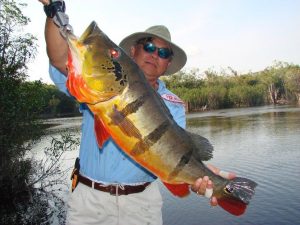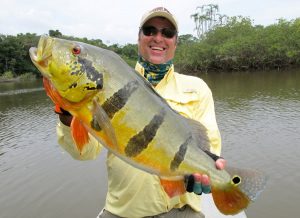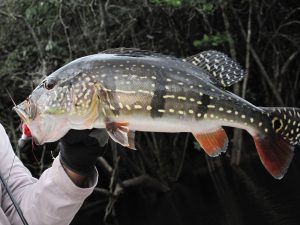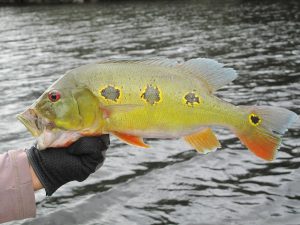Amazon River Species
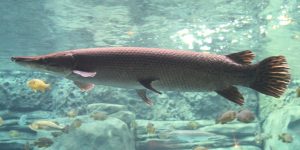 Gator gars are so called because of their reptilian appearance and long jaws, armed with a double row of sharp teeth. They are voracious ambush predators and have been known to bite humans on occasion, although no confirmed deaths due to alligator gars have been recorded to date.
Gator gars are so called because of their reptilian appearance and long jaws, armed with a double row of sharp teeth. They are voracious ambush predators and have been known to bite humans on occasion, although no confirmed deaths due to alligator gars have been recorded to date.
Gars are among the oldest fish alive today. The fossil record traces the existence of alligator gars back to the Early Cretaceous over a hundred million years ago. Gars are often referred to as “primitive fishes”, or “living fossils” because they have retained some morphological characters of their earliest ancestors, such as a spiral valve intestine which is also common to the digestive system of sharks, and they can breathe both air and water. They are considered euryhaline because they can adapt to varying salinities ranging. Alligator gars have been extirpated from much of their historic range through habitat destruction, indiscriminate culling, and unrestricted harvests.
Their bodies are torpedo shaped, usually brown or olive fading to a lighter gray or yellow ventral surface. They do not have scales like other fish, rather they are armored for protection against predation with hard, enamel-like, jagged diamond-shaped ganoid scales that are nearly impenetrable. Unlike other gar species, mature alligator gars have a dual row of large sharp teeth in the upper jaw which they use for impaling and holding prey. They are stalking, ambush predators that are primarily piscivores, but will also ambush and eat water fowl and small mammals that may be floating on the surface.
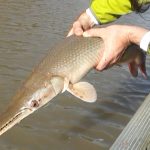 Size / Weight:
Size / Weight:
Anecdotal scientific reports suggest that alligator gars can grow up to 10 ft (3.0 m) in length and weigh as much as 300 lb (140 kg); however in 2011 the largest alligator gar ever caught and officially recorded was 8 ft 5 1⁄4 in (2.572 m) long, weighed 327 lb (148 kg), and was 47 in (120 cm) around the girth.
Feeding behavior:
Alligator gars are relatively passive, seemingly sluggish solitary fish, but voracious ambush predators. They are opportunistic night predators and are primarily piscivores, but they will also ambush and eat water fowl and small mammals that may be floating on the surface. Their method of ambush is to float a few feet below the surface, and wait for unsuspecting prey to swim within reach. They lunge forward, and with a sweeping motion grab their prey, impaling it on their double rows of sharp teeth.
 Spawning:
Spawning:
As with most ancestral species, alligator gars are long living, and sexually late maturing. Most females do not reach sexual maturity until after their first decade of life while males reach sexual maturity in half that time. The conditions must be precise for a successful spawning to occur. Preparation for spawning begins in the spring with the extended photoperiod and rising water temperatures, but flooding is also necessary to trigger the event. When rivers rise and spread over the floodplain, they create oxbow lakes and sloughs, and inundate terrestrial vegetation which in turn provides protection and a nutrient rich habitat for larval fishes, and fry.
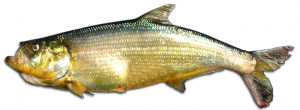 Common name: The freshwater fish called Apapá is popularly known as “Sardinhão”.
Common name: The freshwater fish called Apapá is popularly known as “Sardinhão”.
Scientific name: Pellona castelnaeana.
Geographic distribution: His species is distributed in the Amazon basin, Araguaia-Tocantins, Prata and Pantanal.
Habitat: The Apapa is a pelagic fish (inhabit the surface and midwater), occurring in rivers, lakes and flooded forests. Small schools are common in rapids.
Feeding: It is a carnivorous fish, feeding on insects and small fish on the water surface.
Reproduction: The Apapa performs the migration to spawn.
Biology: The Apapa is a fish scales with compressed body, small head, small mouth, slightly upwards. It has serrated pre-ventral region, adipose fin and lateral line, usually absent. Its color is yellow and its back dark.You can reach more than 60 cm in total length and weigh up to 7 lbs.
 The Arapaima fish is also known as the Pirarucu, is the second freshwater largest fish the world, after the Beluga Sturgeon (Huso huso). Its scientific name is Arapaima gigas. This fish can only be found wild in the Amazon River Basin in South America. It can reach a length of 450 centimeters (177.17 inches) and weigh up to 200 kilograms (440 lbs).
The Arapaima fish is also known as the Pirarucu, is the second freshwater largest fish the world, after the Beluga Sturgeon (Huso huso). Its scientific name is Arapaima gigas. This fish can only be found wild in the Amazon River Basin in South America. It can reach a length of 450 centimeters (177.17 inches) and weigh up to 200 kilograms (440 lbs).
Classification / Names
Actinopterygii (ray-finned fishes) > Osteoglossiformes (Bony tongues) > Arapaimidae (Bonytongues)
Size / Weight / Age
Max length: 450 cm TL male/unsexed; common length: 200 cm TL male/unsexed; max. published weight: 200.0 kg
Environment
Freshwater; demersal; pH range: 6.0 – 6.5; dH range: 10 – ?
Climate / Range
Tropical; 25°C – 29°C; 5°N – 11°S
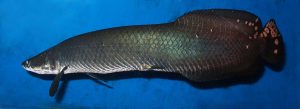 Distribution
Distribution
South America: Amazon River basin. International trade is restricted. Active fishing for Arapaima has reduced both the population size and the occurrence of large individuals, especially near the populated regions of the Amazon.
Biology
It is often referred to as the largest freshwater fish. It builds a nest of about 15 cm deep and 50 cm wide in sandy bottoms. Spawns in April and May and guards the eggs and the young. Arapaima are air-breathers. They rise to the surface of the water and take in air with a loud, distinctive gulp, which is reported to carry for long distances.
Also known as: paiche, pirarucú.
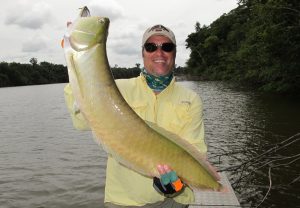
Classification / Names
Actinopterygii (ray-finned fishes) > Osteoglossiformes (Bony tongues) > Osteoglossidae (Arowanas)
Size / Weight / Age
Max length : 90.0 cm TL male/unsexed; max. published weight: 6,000 g.
Environment
Freshwater; benthopelagic.
Climate / Range
Tropical; 24°C – 30°C
Distribution
South America: Amazon River basin, Rupununi and Oyapock Rivers.
Short description
Body covered with very big scales; dorsal and anal fins almost fused with the caudal fin; and 2 barbels at the extremity of the lower jaw. Adults are silvery, juvenile with blue glints and a yellow-orange bar.
Biology
These fish are omnivores with a tendency to feed on fish at the surface. The superior position of the mouth allows it to capture its prey while swimming from below. It also jumps out of the water to feed on large insects (Coleoptera). It is capable of adapting to environments with low oxygen levels.
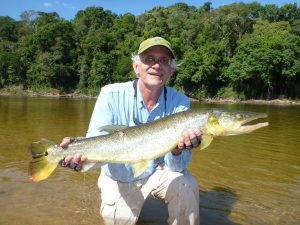 Classification / Names
Classification / Names
Actinopterygii (ray-finned fishes) > Characiformes (Characins) > Ctenoluciidae (Pike-characids)
Size / Weight / Age
Max length : 88.0 cm FL male/unsexed; max. published weight: 6,000 g.
Environment
Freshwater; pelagic
Climate / Range
Tropical
Distribution
South America: Amazon River, Tocantins River, Orinoco River, Essequibo River, Oyapock River [= Oiapoque] and rivers of Amapá and Pará, Brazil.
Short description
Dorsal spines (total): 0; dorsal soft rays (total): 10-11; anal spines: 0; anal soft rays: 9 – 11; vertebrae: 48 – 49. The location of the dorsal fin base distinctly anterior to the vertical through the anal fin origin distinguishes this species from all ctenoluciids except B. lucius and B. xyrekes, from which it can be distinguished by the discrete black spot on the basal portions of the caudal fin rays, and also by different pigmentation on the body.
Biology
It usually inhabits areas with rapid water, always on the surface, behind obstacles like rocks and logs. Some small-sized individuals occur in calmer waters such as lakes, small bays. It occurs solitary or forms small schools. It is a carnivorous fish with a preference to eat other fish.
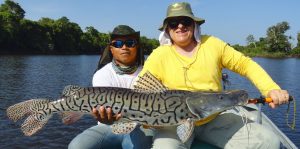 Leather fish has elongated body, plump and large, flat head. The color is dark gray on the back, clearing towards the belly, and whitish below lateral line. Large species, reaching over 1.30 meters in total length and just over 20 kg of weight.
Leather fish has elongated body, plump and large, flat head. The color is dark gray on the back, clearing towards the belly, and whitish below lateral line. Large species, reaching over 1.30 meters in total length and just over 20 kg of weight.
Etymology: Pseudoplatystoma: Greek, pseudes = false + Greek, platys = flat + Greek, stoma = mouth
Distribution: Widespread in the Amazon and Orinoco Basins.
Habitat: Large secured pieces of bogwood and rock. Temperature: 22.0-26.0°C or 71.6-78.8°F.
Feeding: Fish, crustaceans and prawns and literally anything that it finds tasty and small enough to eat.
Identification: It can be separated from the other species of the genus by the irregular black spots like a tiger, beginning in the dorsal region and extend to below the lateral line. Vertical to slightly oblique black stripes; often has spots, which are thicker on the ventral side; great variation in stripe and spot patterns. Eigenmann recognized at least 14 varieties or subspecies based on colour patterns; easily confused with other members of the genus. The Caparari presents a narrowing of the head, which also differentiates it from other species of the genus.
Biology: Occurs in estuarine zones, mainly upstream of the first rapids up to the basin’s headwaters. Nocturnal species which lives in the main bed of slow or fast zones, as well as in the flooded forests, particularly the juveniles., Opportunistic, piscivorous fish which may feed on crabs and shrimps. At the end of the dry season, they can migrate at the same time as their prey, then return at the end of the rainy season. Most important catfish in gill-net fisheries of Guaporé and Mamoré rivers.
Also known as: La Doncella (Perú).
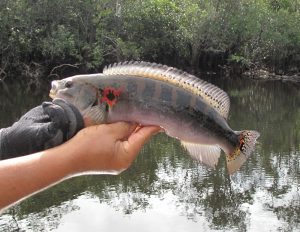
Classification / Names
Actinopterygii (ray-finned fishes) > Perciformes (Perch-likes) > Cichlidae (Cichlids) > Cichlinae
Size / Weight / Age
Max length : 24.0 cm
Environment
Freshwater; benthopelagic; pH range: 5.5 – ?
Climate / Range
Tropical; 25°C – 30°C
Distribution
South America: Amazon River basin, in the Branco, Negro and Uatumã rivers in Brazil; Essequibo River and Branco River in Guyana; Corantijn River in Suriname.
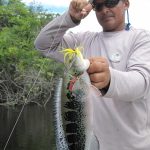 Biology
Biology
It is often found in creeks, but it is also sometimes captured in rivers, especially during the dry season. It is a formidable predator; essentially consuming aquatic insects, fish and plant material. It is not very popular among aquarists because of its aggressive behavior.
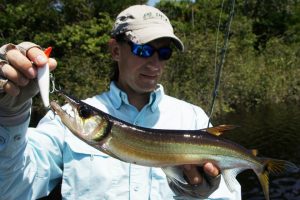 Family: Acestrorhynchidae
Family: Acestrorhynchidae
Genus: Acestrorhynchus
Size / Weight / Age
They range from 35 to 400 mm in length
Distribution
Acestrorhynchus (“needle jaw”) is a genus of 14 species of characiform fish found only in fresh water in South America, the sole genus in the family Acestrorhynchidae. Their greatest diversity is in the Orinoco and Amazon basins. They are found in a variety of habitats, but primarily live in lakes, lagoons and areas near shore. The smallest species of this fish are especially found in small streams (igarapés) of the Amazon basin
These fish have elongated pike-like bodies and large conical teeth, adapted for predation on other types of fish. They are sometimes referred to as freshwater barracudas in the aquarium trade, although the name is used to refer to other characins, as well.
Common names are: cachorinho, cachorro, pez cachorro, pez zorro, pike characin, freshwater barracuda and dientudo
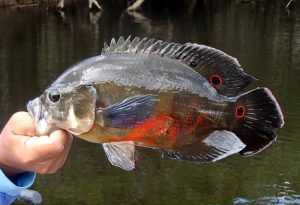
Distribution
Widely-distributed in the Amazon region and has been recorded in Colombia, Venezuela, Bolivia, Ecuador, Peru, Brazil, French Guiana, Paraguay, Uruguay and Argentina. Across this range it has been collected from numerous river systems, including the Ucayali, Solimões, Amazonas, Negro, Madeira, Tapajós, Tocantins, Orinoco, Approuague, and Oyapock. Feral populations also exist in several countries, including Singapore and the USA.
Habitat
Most often found in the shallows of slow-moving or still waters in forested areas. It appears to favour silt-laden white water habitats, where it is typically associated with submerged tree roots or under cover of marginal vegetation.
Maximum Standard Length: 250 – 350 mm.
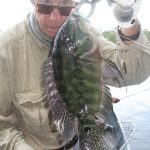 Diet
Diet
This species is a generalised omnivore, feeding on a range of items including smaller fish, insects, crustaceans, zooplankton and various types of both terrestrial and aquatic vegetation in the wild, although meatier foods appear to be the preferred option with fruit and other plant material being taken when prey is scarce.
This species is also referred to as: ‘velvet cichlid’, ‘red oscar’, ‘tiger oscar’, or ‘marble cichlid’.
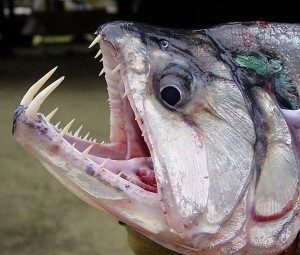 The Payara, Hydrolycus scomberoides, also known as “Dog Tooth Characin”, “Vampire Fish”. Much appreciated sport fish due to the impressive fights they put up. Payara are widely considered to be one of the fiercest struggling freshwater fishes, offering harder fight than other popular fishes from the area such as peacock bass. They also add to the sport of catching them by jumping out of the water much the way salmon do.
The Payara, Hydrolycus scomberoides, also known as “Dog Tooth Characin”, “Vampire Fish”. Much appreciated sport fish due to the impressive fights they put up. Payara are widely considered to be one of the fiercest struggling freshwater fishes, offering harder fight than other popular fishes from the area such as peacock bass. They also add to the sport of catching them by jumping out of the water much the way salmon do.
Payara usually hunt in deeper water rather then at the surface, so sinking lures such as spoons and jigs are the best choice.
Classification / Names
Actinopterygii (ray-finned fishes) > Characiformes (Characins) > Cynodontidae (Dogtooth characins) > Cynodontinae
Size / Weight / Age
Max length : 117 cm TL male/unsexed; max. published weight: 17.8 kg
Environment
Freshwater; benthopelagic
Climate / Range
Tropical; 24°C – 28°C
Biology
It is apparently carnivorous, probably ichthyophagous. The maximum length is reported to reach 40 cm.
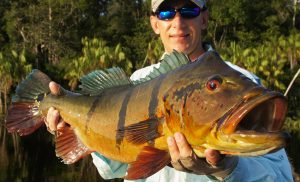
Classification / Names
Actinopterygii (ray-finned fishes) > Perciformes (Perch-likes) > Cichlidae (Cichlids) > Cichlinae
Size / Weight / Age
Max length : 74.0 cm TL male/unsexed; max. published weight: 6,800g.
Environment
Freshwater; brackish; benthopelagic; depth range 5 – ? m.
Climate / Range
Tropical; 24°C – 27°C; 26°N – 9°S
Short description
Diagnosis. Distinguished from all other species of Cichla except C. nigromaculata, C. intermedia, C. piquiti, and C. melaniae, by presence of bars 1a and 2a. Lateral band abbreviated in juveniles. Distinguished from its congeners with abbreviated lateral band by lateral line usually continuous (vs. discontinuous or nearly always discontinuous in orinocensis and nigromaculata); scales in E1 row (67-) 70-80 (-82) (vs. 84-93 in pleiozona); occipital bar absent or indistinct (vs. emphasized in adults of monoculus, kelberi, and pleiozona); abdominal blotches present (vs. absent in orinocensis); vertical bars present in adult size (vs. three midlateral ocellated blotches in orinocensis), except that an ocellated blotch consistently formed in dorsal portion of bar 3; absence of small black blotches on dorsum (vs. present in nigromaculata); vertical bars about equally wide across side (vs. wide, occasionally confluent dorsally, and tapering ventrad in nigromaculata, monoculus, kelberi, and pleiozona). Distinguished from C. intermedia, C. piquiti, and C. melaniae by abbreviated vs. complete juvenile lateral band, less scales in E1 row (67-82 vs. (78) 83-108), and presence of ocellated blotch in dorsal portion of bar 3 vs. absence.
Biology
Peacock Bass occur in rapids and in quiet waters with medium depth and rocky substrates. They forms schools; and feeds only on small fish, especially threadfin shad, mosquito fish, tilapia and bluegill. Peacock Bass are not considered ideal for aquaculture due to their highly predatory habits. Reproduction occurs year-round, with a peak at the start of the rainy season. About 9,000 to 15,000 eggs per kg are released during spawning. Spawning take place every two months on a flat stone in shallow waters. The sticky eggs, measuring 1.4 mm in diameter, take 78 hours to hatch at 28°C.
Species of peacock bass in the genus Cichla (the category of fish peacocks belong):
Tucunaré peacock bass (Cichla Temensis)
“Borboleto” (butterfly) peacock bass (Cichla Orinocensis)
Also known as: Tucunaré (Brazil), Pavón (América Latina).
Visit the Peacock Bass page for more information about this great fish.
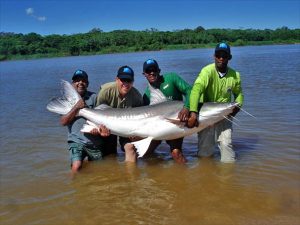
Nome popular: O peixe de água doce chamado Piraíba é conhecido popularmente como Filhote.
Common name: The freshwater fish called Piraíba is popularly known as “Filhote” (puppy).
Nome científico: Brachyplatystoma filamentosum.
Scientific name: Brachyplatystoma filamentosum.
Geographic distribution: Your species is distributed in the Amazon and Tocantins-Araguaia basins.
Habitat: The Piraíba dwells deep gutters of large rivers.
Feeding: It is a carnivorous fish, with fish-eating trends, catching other fish.
Reproduction: It is able to migrate 2500 miles (4000 km) to find the ideal place to launch their eggs.
Biology:
The Piraíba is the biggest leather of fish in the Amazon Basin, reaching 3.2 yards (3 m) in length and 330 pouns (150 kg) weight. It has plump body, depressed head, small eyes and situated on its top. His jaw barbels are plump and very long, about twice the body size, young people, and about 2/3 of the body in adults. Young’s body have light colored, with many dark stains and rounded at its upper end portion, which disappear as the fish grows. .In adults, the color is dark gray-brown, on the back, and clear in the womb. His flesh is not appreciated because many believe is bad and transmits diseases.
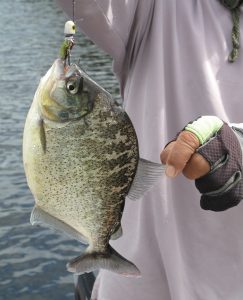 Size / Weight / Age
Size / Weight / Age
Max length : 41.5 cm SL male/unsexed; max. published weight: 3,000 g
Environment
Freshwater; benthopelagic; pH range: 5.8 – 7.0
Climate / Range
Tropical; 23°C – 27°C
Distribution
South America: Amazon and Orinoco River basins, north and eastern Guiana Shield rivers, and northeastern Brazilian coastal rivers.
Biology
It occurs in rapids mostly, but is also captured in deep zones of main rivers with the use of fish bait. It is essentially a carnivore, feeds on small fish, crabs, mammals, lizards and coleopteran insects. Its opportunistic behavior allows it to adapt to various biotopes. It is timid and not aggressive but it possesses powerful teeth that can cause serious bites, and is therefore, potentially dangerous.
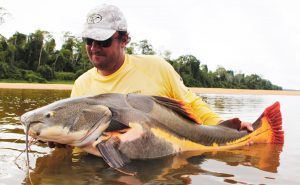 The Redtail Catfish is one of the most colorful of the large catfishes found in the Amazon and Orinoco basins.
The Redtail Catfish is one of the most colorful of the large catfishes found in the Amazon and Orinoco basins.
Classification / Names
Actinopterygii (ray-finned fishes) > Siluriformes (Catfish) > Pimelodidae (Long-whiskered catfishes)
Size / Weight / Age
Max length: 134 cm TL male/unsexed; common length: 60.0 cm TL male/unsexed; max. published weight: 44.2 kg
Environment
Freshwater; demersal; pH range: 5.5 – 6.8; dH range: ? – 10; potamodromous
Climate / Range
Tropical; 20°C – 26°C
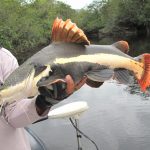 Distribution
Distribution
South America: Amazon and Orinoco River basins.
Biology
It occurs in littoral creeks, over sandy bottoms covered with dead leaves. It also inhabits lakes and rivers, but seems to prefer rivers with very slight currents. It prefers a muddy bottom covered with leaves and decaying wood, the latter providing for hiding places during the day. It feeds on fish, crabs and fruits.
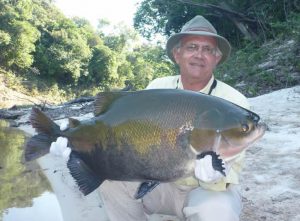
The tambaqui (Colossoma macropomum) is a freshwater fish of the subfamily Serrasalminae, family Characidae. It is also known by the names pacu, black pacu, black-finned pacu, giant pacu, cachama and gamitana.
Classification / Names
Actinopterygii (ray-finned fishes) > Characiformes (Characins) > Serrasalmidae
Etymology: Colossoma: Greek, kolos = short, truncated + Greek, soma = body
Size / Weight
Max length: 108 cm / Common length: 70.0 cm / Max. published weight: 40.0 kg
Distribution
South America: Amazon and Orinoco basins as wild form; pisciculture form largely distributed in South America.
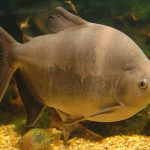
 Biology
Biology
This species is usually solitary. Adults stay in flooded forests during first 5 months of flooding and consume nothing but fruits and grains. Young and juveniles live in black waters of flood plains until their sexual maturity. Feeds on zooplankton, insects, snails and decaying plants. Used in aquaculture because it can live in mineral poor waters and is very resistant to diseases.
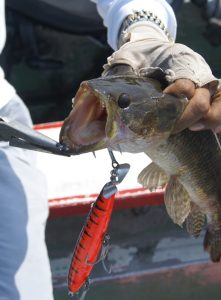
Wolf Fish (Traira in Brazil, Aimara in Venezuela and Suriname) are a mean-looking Amazonian fish. They have jaws of iron with wicked sharp round teeth and have been known to latch onto people who have ventured into their territory. There are two primary species: the smaller malabaricus which grows to around 10lbs and the lacerdae which grows much larger.
Classification / Names
Actinopterygii (ray-finned fishes) > Characiformes (Characins) > Erythrinidae (Trahiras)
Size / Weight / Age
Max length : 100.0 cm SL male/unsexed; max. published weight: 40.0 kg
Environment
Freshwater; benthopelagic; potamodromous
Climate / Range
Tropical
Distribution
South America: Tributaries of middle and lower Amazon basin, including the rivers Trombretas, Jari, Tapajós, Xingu, Tocantins, and in the coastal rivers of Guyana, Suriname, Fr Guiana; rivers Araguari and Amapá, state of Amapá, Brazil; lower reaches of Orinoco River, Venezuela.
Biology
It frequently occurs in counter current zones of principal rivers and creeks. It feeds mainly on fish but also on other animals that fall into the water such as small terrestrial invertebrates. Is active at dusk and at night. Reproduction takes place at the onset of the rainy season from December to March. Depending on the size, the female can carry around 6,000 to 60,000 eggs. It is known for the quality of its flesh.
Also known as: Traira (Brazil), Aimara (Venezuela/Suriname), Guavinas (Venezuela), Tararira (Uruguay/Argentina), Dormilón mocholo (Colombia).
Data taken from: RPA collaborators experts, FishBase.org and Wikipedia.org.

